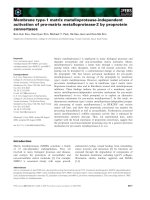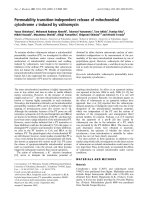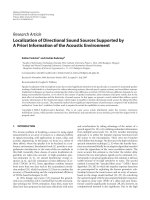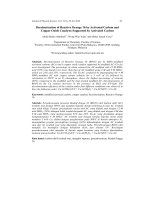STRATEGIES OF INDEPENDENT STRATEGIC READERS SUPPORTED BY THIS READING TOOL
Bạn đang xem bản rút gọn của tài liệu. Xem và tải ngay bản đầy đủ của tài liệu tại đây (127.36 KB, 14 trang )
<span class="text_page_counter">Trang 1</span><div class="page_container" data-page="1">
READINGSTRA TEGIES
About ASCD . . . v
About the Authors . . . vi
Acknowledgments . . . vii
<b>RATIONALE AND PLANNINGSection 1: Why Teach Reading Skills in My Content Area? . . . 3</b>
<b>Section 2: Understanding the Reading Process . . . 5</b>
<b>Section 3: Assigning the Reading Task . . . 8</b>
<i>Reading Tool: Reading Assignment Planning . . . 11</i>
<b>Section 4: Strategies Used by Independent Strategic Readers . . . 19</b>
<b>Section 5: Understanding Text Features . . . 27</b>
<b>Section 6: Planning Tools . . . 30</b>
<i>Reading Tools and Strategies Chart . . . 31</i>
<i>Log of Reading Tools Used . . . 35</i>
<b>Section 7: Selecting and Using the Reading Tools . . . 39</b>
<i>Identifying the Tools: Prereading, During-Reading, and Postreading Activities . . . 41</i>
<i>The Reading Tools and Classroom Instruction </i> That Works . . . 45
<b>READING TOOLS . . . .53</b>
</div><span class="text_page_counter">Trang 2</span><div class="page_container" data-page="2">The Five Ws and H for . . . . . . 69
From Another Perspective . . . 73
Front-Load the Words . . . 77
Get to the Root of It . . . 81
How Sure Are You? . . . 85
In with the Old, Out with the New . . . 89
Sort and Select . . . 121
The Sum of the Parts . . . 125
Thinking About My Text . . . 129
Ticket to Enter . . . 133
True or False? I Predict It Is . . . . . . 137
Vocabulary Wheels . . . 141
What Do You Know About . . . ? . . . 145
What Do You Think Now . . . and Then? . . . 149
What It Is, and What It’s Not . . . 153
What’s the Connection? . . . 157
Word Within a Word . . . 161
Another Kind of Outline . . . 191
The Bow Tie . . . 195
Bubble Chart to Identify Characteristics
Compare the Two . . . 219
Comparison Matrix Chart . . . 223
Connections, Points, and Questions . . . 227
Episodic Summary of . . . . . . 231
From the Way I See It . . . 235
A Gem of an Idea . . . 239
Half Full or Half Empty? . . . 243
How Is One Just Like the Other? . . . 247
It All Comes Together . . . 251
Map the Five Ws and H . . . 255
The Missing Pieces . . . 259
Pass the Paper . . . 283
Pause and Reflect . . . 287
Pearls of Wisdom . . . 291
Pie or Circle Graph . . . 295
Questions, Questions, Questions . . . 299
Read! Listen! Conclude! . . . 303
Reciprocal Teaching—Summarize, Question, Clarify, Predict . . . 307
Stop and Think . . . 311
<i>Think Then React . . . 315</i>
Through the Years . . . 319
Two Sources—One Issue . . . 323
What’s Your Take? . . . 327
Who Are the “Big Players”? . . . 331
<b>Postreading Activities </b> Bar Graph . . . 337
The Fishbone . . . 341
The Height of the Action . . . 345
If Once Is Good, Twice Is Even Better! . . . 349
Line Graph . . . 353
Making an Analogy . . . 357
Negotiate Your Learning . . . 361
One Word to Sum It All Up . . . 365
The Real Problem Is . . . . . . 369
Somebody Wanted in . . . . . . 373
Ticket Out of Here . . . 377
Two Heads Are Smarter Than One . . . 381
What If? . . . 385
R E A D I N G T O O L S
</div><span class="text_page_counter">Trang 3</span><div class="page_container" data-page="3"><small>R E A D I N G S T R A T E G I E S F O R T H E C O N T E N T A R E A SP R E R E A D I N G S T R A T E G I E S</small>
<b>H O W T O U S E :</b>
☛ Identify key root words for subject-area vocabulary.
☛ Have students identify the meaning of roots. They may need to use a dictionary. ☛ Ask students to share subject-area and “real-world” words that use the root word. ☛ Have students share their words in pairs, in small groups, or as a class.
<b>T I P S / V A R I A T I O N S :</b>
☛ Use this strategy for all subject areas.
☛ Have students collect “roots” as they encounter new words in subject-area content, adding to the chart as they encounter words that share common roots.
☛ As an ongoing review, post a chart listing the roots that have been used.
G E T T O T H E R O O T O F I T
<b><small>Strategies of Independent Strategic Readers Supported by this Reading Tool:</small></b>
■✔ <small>1. Have strategies to use when encountering new words.</small>
■✔ <small>2. Connect new knowledge to make meaning. </small>
■ <small>3. Think ahead to what might be coming.</small>
■✔ <small>4. Continually evaluate own understanding.</small>
■ <small>5. Create images of what is being read.</small>
■✔ <small>6. Periodically summarize what is read.</small>
■ <small>7. Use textual cues, visuals, and organization.</small>
■ <small>8. Have a plan for how to approach the task.</small>
R e a d i n g T o o l
</div><span class="text_page_counter">Trang 4</span><div class="page_container" data-page="4"><b>Do You Know Your Roots?</b>
<b>Directions: Identify the meaning of the root and provide examples from the subject area and from the real</b>
<b>MeaningSubject-Area WordReal-World Word</b>
Your teacher identi-fies the roots that are appropriate for
</div><span class="text_page_counter">Trang 5</span><div class="page_container" data-page="5"><b>Do You Know Your Roots?</b>
<b>Directions: Identify the meaning of the root and provide examples from the subject area and from the real</b>
</div><span class="text_page_counter">Trang 6</span><div class="page_container" data-page="6"><b>Do You Know Your Roots?</b>
<b>Directions: Identify the meaning of the root and provide examples from the subject area and from the real</b>
<b>MeaningSubject-Area WordReal-World Word</b>
</div><span class="text_page_counter">Trang 7</span><div class="page_container" data-page="7">☛ As students read about the event or process, have them identify each important event or step by noting it in one of the links of the chain. Caution students to be certain that the events or steps are in the proper order. ☛ Tell students to use as many links as they need to be sure they are including all significant events or steps.
<b>T I P S / V A R I A T I O N S :</b>
☛ Make a chain from loops of construction paper, with each step or event written on a link before they are connected.
☛ Suggest that students color-code the links with various colors signifying particularly important events or steps. For example, red might be used to signify turning points in an event or critical steps in a process. ☛ Note any details about each step in the process or each event in the link.
☛ As a review, give students the events or steps in random order, which they would then place in the appropriate order on the chain.
☛ Remember to help students “shape” the steps by helping them recognize the importance of order, the impact if steps are out of order, and a vision of the intended result.
C H A I N R E A C T I O N
<b><small>Strategies of Independent Strategic Readers Supported by this Reading Tool:</small></b>
■ <small>1. Have strategies to use when encountering new words.</small>
■ <small>2. Connect new knowledge to make meaning. </small>
■ <small>3. Think ahead to what might be coming.</small>
■✔ <small>4. Continually evaluate own understanding.</small>
■✔ <small>5. Create images of what is being read.</small>
■✔ <small>6. Periodically summarize what is read.</small>
■ <small>7. Use textual cues, visuals, and organization.</small>
■ <small>8. Have a plan for how to approach the task.</small>
R e a d i n g T o o l
</div><span class="text_page_counter">Trang 9</span><div class="page_container" data-page="9">Mexican-American<sub>W</sub><sup>ar—debate about</sup>which new territories<sub>should be fr</sub>
</div><span class="text_page_counter">Trang 11</span><div class="page_container" data-page="11"><small>R E A D I N G S T R A T E G I E S F O R T H E C O N T E N T A R E A SP O S T R E A D I N G A C T I V I T I E S</small>
<b>H O W T O U S E :</b>
☛ Identify two ideas about the concept that have a relationship with each other. This relationship might be one of the following:
☛ Identify another set of items that students are familiar with that has the same kind of relationship as the two identified from the reading.
☛ After the students complete the reading assignment, have them use their knowledge about the concept to explain how the relationship of the first set is like the relationship of the second set.
<b>T I P S / V A R I A T I O N S :</b>
☛ Model the thinking of how an analogy is formed by sharing a complete analogy.
☛ The first time students use this tool, have them to work only on comparing the relationships between the two sets of items. As they become more comfortable with making analogies, ask them to complete one or more of the parts of the analogy (the four boxes) as well as define how the relationships are alike.
☛ Keep in mind that the more parts of an analogy the student must complete, the more difficult it will be. Eventually, you can have students create the second set of relationships on their own.
☛ Ask students to create complete analogies and then have peers determine the relationships.
M A K I N G A N A N A L O G Y
<b><small>Strategies of Independent Strategic Readers Supported by this Reading Tool:</small></b>
■ <small>1. Have strategies to use when encountering new words.</small>
■✔ <small>2. Connect new knowledge to make meaning. </small>
■ <small>3. Think ahead to what might be coming.</small>
■✔ <small>4. Continually evaluate own understanding.</small>
■ <small>5. Create images of what is being read.</small>
■✔ <small>6. Periodically summarize what is read.</small>
■ <small>7. Use textual cues, visuals, and organization.</small>
■ <small>8. Have a plan for how to approach the task.</small>









